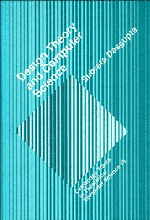Book contents
- Frontmatter
- Contents
- Preface
- Acknowledgements
- Part I The Architectonics of Design
- 1 The Inadequacy of Definitions
- 2 Design as the Initiation of Change
- 3 The Nature of Design Problems
- 4 The Form of Design Solutions
- 5 The Evolutionary Structure of Design Processes
- Part II Design Paradigms
- Part III Design and Science
- References
- Index
4 - The Form of Design Solutions
Published online by Cambridge University Press: 10 February 2010
- Frontmatter
- Contents
- Preface
- Acknowledgements
- Part I The Architectonics of Design
- 1 The Inadequacy of Definitions
- 2 Design as the Initiation of Change
- 3 The Nature of Design Problems
- 4 The Form of Design Solutions
- 5 The Evolutionary Structure of Design Processes
- Part II Design Paradigms
- Part III Design and Science
- References
- Index
Summary
As stated at the beginning of chapter 3 the designer's brief is to develop a form such that an artifact constructed according to this form would satisfy the requirements. The form is the design. The ultimate output of a design process must, then, be an explicit description or representation of the form in some abstract or symbolic language. I shall use the term design description to refer to such symbolic representations of forms. When ‘design’ is used as a noun it becomes essentially a synonym for ‘form’.
The concept of form is elusive, abstract, and complex. It may refer to the visible shape of an entity – as when naturalists and biologists talk of biological forms. It may refer to the essential or ultimate nature of a thing – as when philosophers talk of Platonic forms. It may denote the way in which certain parts are arranged and related to one another in an entity – as when one talks of the form of an essay, an argument, a solution, or a musical composition. Finally, architects talk of forms or ‘built’ forms (March 1976, Alexander 1964) in which term they embrace in a complex, diffuse fashion, the totality of shape, structure and relationships of parts as manifested in buildings.
These examples clearly reveal that form as a general concept is multifaceted. Thus, when we undertake to design an artifact the end product of our activity – the form of the artifact itself and how it is to be described – is critically dependent on how or for what purpose the design is to be used.
- Type
- Chapter
- Information
- Design Theory and Computer Science , pp. 36 - 61Publisher: Cambridge University PressPrint publication year: 1991



